Google AdWords Automated Rules: Three Valuable Uses
Cutting down on the time required to manage PPC accounts is a great thing, especially when you manage multiple accounts. One awesome tool that many advertisers overlook is the quick and easy Automated Rules tool in Google AdWords.
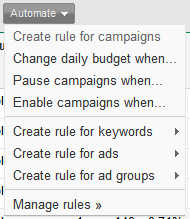
Automated Rules are available to all AdWords advertisers, and are extremely useful at automatically making changes to your account that you would otherwise spend time making on a regular basis. Here are three great ways that I put Automated Rules to work, so that I can spend time on some other optimizations:
Brand Management
I wrote a blog post on the importance and value of managing one’s Brand, and this little tidbit builds upon that. I recommend always bidding on Brand terms within PPC campaigns, for a variety of reasons. When doing so, it’s important to make sure your ads appear in the top positions, so that those searching for your Brand see your ad first. Rather than constantly logging into AdWords to check the position of each individual Brand keyword, making changes to move its position up, Automated Rules can do this for you.
The rule that you will set for Brand keywords is a “Change Max CPC bids when” rule that will be based on average position. I personally prefer my Brand keywords to remain at an average position of 1.3 or higher, occasionally 1.5 or higher, depending on the competitive landscape, the industry, how generic the brand name may be, etc. Given that specification, I then set the rule to raise brand Max CPC bids if/when the average position is lower than that, usually by between 10% – 15% (also dependent upon the competitive landscape, etc). Here is an example of how the rule would look when complete:
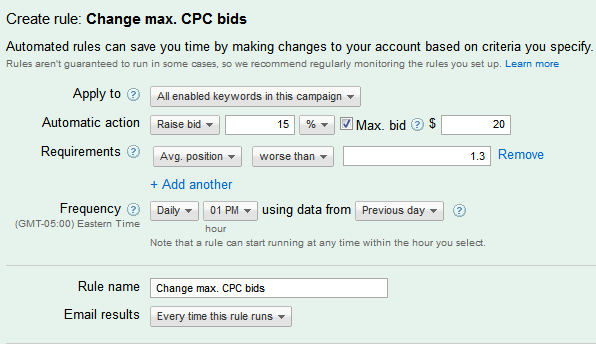
Another way to ensure your Brand keywords remain at the top of the page is to implement a rule that does just that: raises bids to top of page CPC. While I prefer the above approach to have a little more control over the bids and to ensure the keywords remain in the number 1 position rather than 1-3, setting a rule to raise bids to top of page CPC can be a quick and effective way to keep those ads just where you want them.
In order to set this rule, you’ll set a rule for keywords, then click on “Raise bids to top of page CPC when…” For use of this rule, I recommend removing any requirements, due to the main goal being to keep all Brand keywords at the top of the page. A completed rule might look like this:
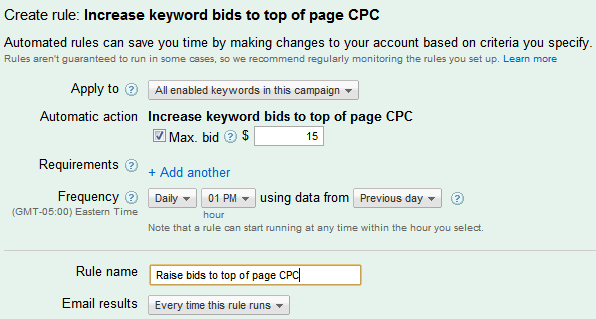
I prefer to use data from the previous day, and have the rule run at either noon or 1:00pm. Depending on the amount of traffic your campaign(s)/keywords receive, you may prefer to base the rule on a longer period of time, or even just from the current date.
Awareness Tactics
A common strategy used by PPC advertisers is ‘Awareness’ – based advertising, which focuses more on impressions and clicks, rather than actual direct response (i.e. conversions, cost-per-conversion, revenue, etc). Awareness campaigns focus on maximizing impressions, (and hopefully clicks), to spread the word about a Brand’s name, getting it noticed, and essentially building awareness for it that will someday turn into conversions or revenue.
When managing Awareness-based campaigns, I work to not only maximize on high-impression terms, but also those that are receiving a strong number of clicks along the way. Since Awareness-based strategies are often more short-term, it’s essential to keep up with managing these dollars, evaluating and making changes on a daily basis. Here is where the AdWords Automated Rules comes in handy. Below is an example of what an Awareness rule might look like when complete. Depending on the size and traffic volume of your account/campaigns, your specified impression or click numbers may vary greatly from this example:
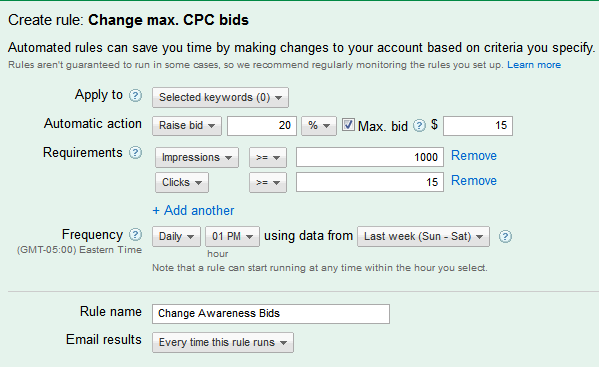
I prefer to base the changes off of a longer period of time than just a day, usually at least a week, for example. Keep in mind it’s not uncommon to base awareness changes/success solely on impressions; I just often choose to add in the clicks metrics, for added result success.
Another way to manage Awareness campaigns is to use the top of page bid rules. You might also choose to specify both impression/click requirements, as shown in the example above. Here’s an example:
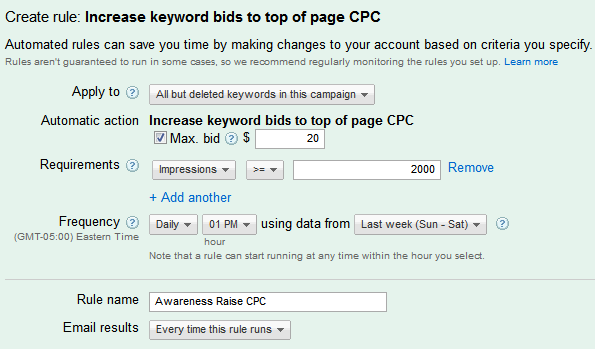
Both strategies can be very effective at managing Awareness campaigns. I recommend using the first Awareness strategy for tighter control on bidding, but tweak the rules to the results of your liking.
Promotional Ad Management
Managing changes in ad copy can be challenging, especially when you manage multiple accounts and certain ads have strict start/stop dates. An example of this that I come across often are when advertisers are running a certain promotion, in which ads should only be running for a certain time frame. While we of course can set calendar reminders of when to turn on/off these promotional ads, AdWords Automated Rules an do this for us, increasing efficiency and ensuring nothing slips through the cracks.
Below is an example of an ad that we want to ensure stops running on a particular day:

By clicking the check box next to the ad within the AdWords UI, clicking “Automate” then choosing a “pause ad when” rule, I can set an automated rule to set this ad to turn on or off at a certain time. In this case, I will set this ad to turn off on April 18th, and set my control/generic ad to turn on in it’s place.
To set this rule, click ‘Remove’ next to any requirements. Next to frequency, choose “one time.” I’ll set the ad to pause at midnight on the day the promotion ends. In this example, the “selected ad” is my control ad, which I put the check mark next to.
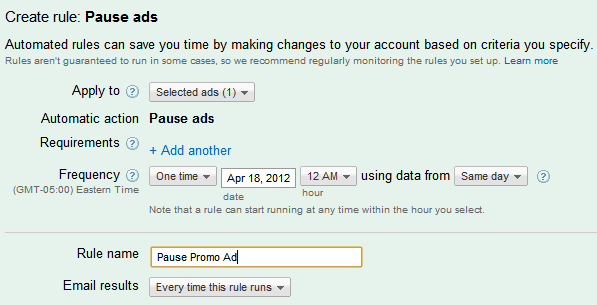
By clicking the check box next to the ad and clicking “Automate,” then choosing a “pause ad when” rule, I can set an automated rule to set this ad to turn on or off at a certain time. In this case, I will set this ad to turn off on April 18th, and set my control/generic ad to turn on in it’s place.
To set this rule, click ‘Remove’ next to any requirements. Next to frequency, choose “one time.” I’ll set the ad to pause at midnight on the day the promotion ends. In this example, the “selected ad” is my control ad, which I put the check mark next to.
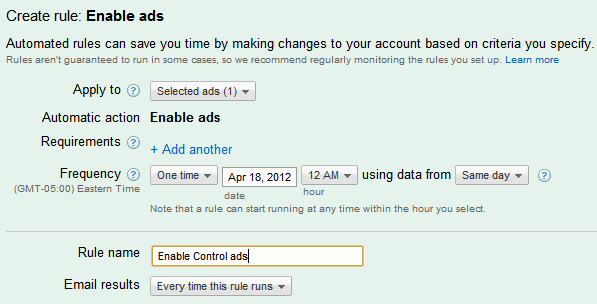
While these are three advertising strategies that can truly benefit from the Google AdWords Automated Rules, the possibilities with Automated Rules can be endless. What are some other ways in which you’ve benefited from the use of AdWords Automated Rules?


